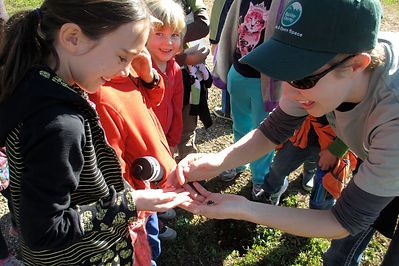Curriculum in Lower Elementary (ages 6-9)
The Blue Spruce, Conifer & Ponderosa Communities
In the Lower Elementary classrooms, the child’s own questions provide the basis for exploration of the world. Children between the ages of six and nine have a natural desire to explore the expansive “cosmic” perspective within disciplines.
This “Cosmic Education” is the framework for the Lower Elementary students’ independent investigations into specific details and topics.

“My vision of the future is no longer of people taking exams and proceeding on that certification ... but of individuals passing from one stage of independence to a higher [one], by means of their own activity, through their own effort of will, which constitutes the inner evolution of the individual.”
– Dr. Maria Montessori
Montessori described three important tendencies emerging at the elementary school age: the transition of the child’s mind from concrete to abstract reasoning; the birth of a moral sense; and the intensification of the drive to explore the natural and social environment.
The Montessori elementary program is designed to meet the needs of each child in a way that is both faithful to Dr. Montessori’s insights and consistent with the expectations of parents and society.
The Five Great Lessons
Traditionally presented every year in the Lower Elementary class as an inspiration to new and older students alike, the Great Lessons are five key areas of interconnected studies in the form of inspiring stories. These Great Lessons comprise Montessori’s “Cosmic Curriculum.”
“The Coming of the Universe” is often the most memorable for children. It tells the story of the beginning of the universe. This story leads to the study of astronomy, meteorology, chemistry, physics, geology, and geography.
“The Coming of Life” tells the story of life on earth prior to the arrival of humans. This story leads to the study of biology, botany, ancient life, and animals.
“The Coming of Humans” involves the arrival of early humans and the three gifts that make humans special: a mind to imagine, a hand to do work, and a heart that can love. This story leads to the study of history, culture, social sciences, and discovery and invention.
“The Story of Writing” tells of the development of communication in signs, with an emphasis on the incredible ability that humans have of committing their thoughts to paper. Included in the story are pictographs, symbols, hieroglyphs, early alphabets, and the invention of the printing press. This story leads to the study of reading, writing, language, and structure.
“The Story of Numbers” begins with the earliest civilizations, who often only had “one,” “two,” and “more than two” as their numeric systems. It continues with a look at different numbering systems throughout the centuries, culminating in the decimal system that we use today. This story leads to the study of mathematics, numbers, geometry, and mathematical application.
After exposure to each Great Lesson, the children, in small groups or individually, freely explore their own questions prompted by the story. Some may work with timelines, others will perform experiments or gather more information through research. The Great Lessons create sustained interest in the themes of progress and interdependency.
The Lower Elementary Environment
Elementary students are encouraged to explore topics that capture their imagination. Elementary Montessori students rarely use textbooks. The learning environment is largely based on library research with children gathering information, assembling reports, teaching what they have learned to their fellow students, and assembling portfolios and handmade books of their own.
Elementary students are taught how to use reference materials, libraries, and the internet to gather information and uncover the facts. Their oral presentations and written research reports grow in sophistication and complexity every year.
The Lower Elementary environment balances the child’s developing imagination and powers of abstraction with down-to-earth, concrete, and hands-on materials.
-
Math is presented through three-dimensional, manipulative materials that simultaneously reveal arithmetic, geometric, and algebraic correlations.
-
Grammar uses symbol and visual patterns to help the child discover parts of speech and analyze the structure, style, and logic of sentences.
-
The sciences are presented through geology, botany, zoology, and basic geographic terminology, laying the groundwork for future in-depth study.
Environmental Education
Students are introduced to the idea of environmental stewardship in order to raise their awareness of issues like resource depletion, environmental pollution, land degradation, and accelerating species extinctions.
Students discuss both how to care for the environment and how to behave in nature. Field trips and “Going-Outs” provide the opportunity to explore beyond the classroom, based on individual or small-group interest as extensions of classroom study.
Trips are taken each year to recycling plants, nature preserves, and other destinations around Longmont, so that students might observe and explore in the natural environment.
Music Appreciation
Art and music are a vitalizing part of the already integrated Lower Elementary environment. Students engage in the grant-funded Brummitt-Taylor Music Listening Program where they focus on the same piece of classical music each day for a week. The songs are chosen to highlight specific musical concepts and connect the students musically to the seasons and areas of the curriculum.
Practical Life
Practical Life exercises continue at the Lower Elementary level with an emphasis on responsibility: responsibility to be gracious and courteous to their fellow students and Guides, responsibility to take care of their classroom environment, and a responsibility to take care of themselves.
Assessment in the Lower Elementary Classroom
Students are assessed individually. Through portfolios, performance, and Guide observation, each student’s academic, emotional, social, artistic, and physical progress is tracked.
Public Montessori schools also participate in national, state, or local assessments and standardized tests. All SVCMS students are assessed in accordance with the Colorado Read Act. Beginning in 3rd year, SVCMS also administers the mandatory state assessments to students in years 3-8.
Interested in joining the St. Vrain Community Montessori School community?
Check out our enrollment information for K-8.
